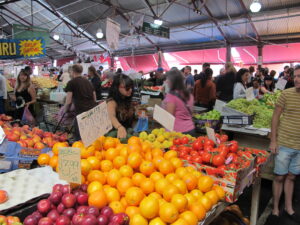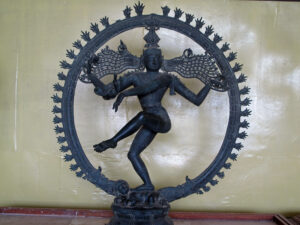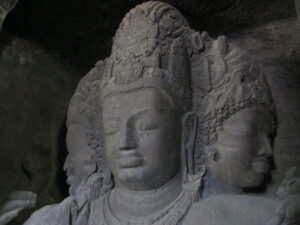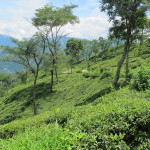
Every so often, just when you think you know a bit, you find you’re just a novice.
We’ve been in India for a few months, but we still open the menu and find dishes whose composition we know nothing about. That’s often because there are really many, many cuisines in India – and varying terminologies across regions – so perhaps it’s not so surprising. Brinjel bharta, anyone?
But here we were in the town of Darjeeling, the name for some of the most renowned tea brews in the world, and a type of tea we’ve had many times. And then we discover we know pretty much nothing about tea.
You do know you’re in tea country way before you get here. The name itself, of course (accent equally on the first two syllables, and derived from Dorjee, thunderbolt, and ling, place). And then there are all the tea growing plantations you pass that start from the lower hillsides above the Gangetic plains in West Bengal state. Hectares and hectares of short bushes (camellias, it turns out) neatly arrayed in dense clusters, carpet the hillsides up to the foot of the Himalayas. Once you arrive in town, tea emporium after tea emporium offers famous Darjeeling tea, at top quality and advantageous pricing. Even the hotels here switch their in-room tea offering from the equivalent of Lipton tea in other cities to local Darjeeling.
But we wanted to go to the source and see a tea-making operation in action. The usual place to go here is Happy Valley tea makers, exclusive supplier to Harrod’s or at least they were when the faded sign was posted. They, however, were not up to speed when we tried to visit due to the Indian celebration of Eid-al-Fitr.
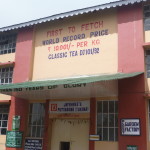 So we went to a smaller operation the next day, Puttabong Tea Estate, an unassuming yellow warehouse down a bumpy and precipitous dirt road, past yet more tea bushes hanging off the steep hill inclines. Out in the fields, a cadre of women walked amid the bushes picking leaves and filling up the conical bamboo baskets on their backs.
So we went to a smaller operation the next day, Puttabong Tea Estate, an unassuming yellow warehouse down a bumpy and precipitous dirt road, past yet more tea bushes hanging off the steep hill inclines. Out in the fields, a cadre of women walked amid the bushes picking leaves and filling up the conical bamboo baskets on their backs.
That, of course, is the first step in the making of tea. The others, at least here, are as labor-intensive as the picking. First there is the withering, as the picked leaves are popped on conveyors and left to air dry. The dried leaves are hauled in oversized milk crates to a staging area and dumped on the floor next to a foot-square hole. A squatting worker then shoves the leaves down the hole.
This might seem primitive, but the product sells at wholesale for $70 to $140 per kilo. This is high quality stuff.
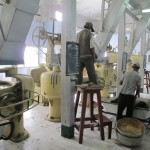
Below the hole, a chute funnels the leaves into the roller, a cylindrical device that rotates above an elliptical plate. Its purpose is to wash and roll the leaves, as well as mash or crush them to get the right oxidation and juices flowing. This place had about a dozen rollers, most of which were hard at work rolling and smushing.
Once the leaves are rolled appropriately, it’s drying/oxidation time as cartloads of the rolled stuff again gets spread out on drying racks. Finally, the tea leaves are sent through an automated machine that spreads them out, bakes them to stop the oxidation and delivers the goods to large sacks for shipping. Out the bottom of this machine, a fine dust of tea debris falls out and is shoveled into another bin. We couldn’t help but think that the dust is what most commodity tea bags use.
Some teas have additional steps and we’re told there are many subtleties in the timing and methodologies of each of the processing steps, all of which affect the qualities of the tea. Like Bordeaux or Bourgogne, Darjeeling seems to offer a world-class combination of plants, terroir and climate for producing a tea of exemplary taste.
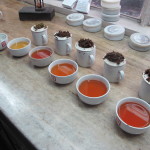
We kept thinking that all we saw and learned was indeed like wine-making, and were convinced of it when we sampled some of the teas produced by this place. Our server drew tea leaves from five tins and prepared five bowls of tea as ceremoniously as a Japanese tea ceremony, complete with an hourglass timer. Three different kind of leaves – orange pekoe silver tips (with little silver bits from some source we weren’t ever clear about), orange pekoe and two types of oolong. But that’s not all. That’s when we found out about the flushes.
Literally, a flush is the part of the bush you’re supposed to pick for highest quality tea: a bud and two leaves at the end of a stalk. And workers become very good at deftly picking these without damaging the plant. But in practice a flush is the season in which the leaves are picked, a timing which changes the tea qualities altogether, The first flush is the early spring and it seems that these young leaves produce a delicate and subtle flavor, apparently heavy in demand but in relatively short supply due to its limited season. The second flush of darker, more mature leaves is the main one over the summer. Some areas have a third flush, which is the source of much low quality tea.
Our five tins included a first flush and second flush of the silver tip orange pekoe, a second flush of the regular orange pekoe, and second flushes of the oolongs. And they were all very different. The first flush OP silver tips was delicate and light, a bit too light for our taste. The second flush had some of the same flavoring, but – much darker – had a tangy edge to it. The second flush of oolong 1 was strong and bracing, but not quite as deep a flavor as we preferred. The other oolong second flush had a sharp aftertaste we found unappealing. For us, it was the straight OP second flush that had the best balance of flavor, richness, depth and smoothness to pass our taste test.
So now we know a little bit more about tea. Sure, tasting wine by the glass has some appealing after-effects. Now, however, we are impressed at the challenge of understanding the varietals, terroirs, processing and subtleties by which tea reaches our cup.
(Also, for more pictures from India, CLICK HERE to view the slideshow at the end of the India itinerary page.)



